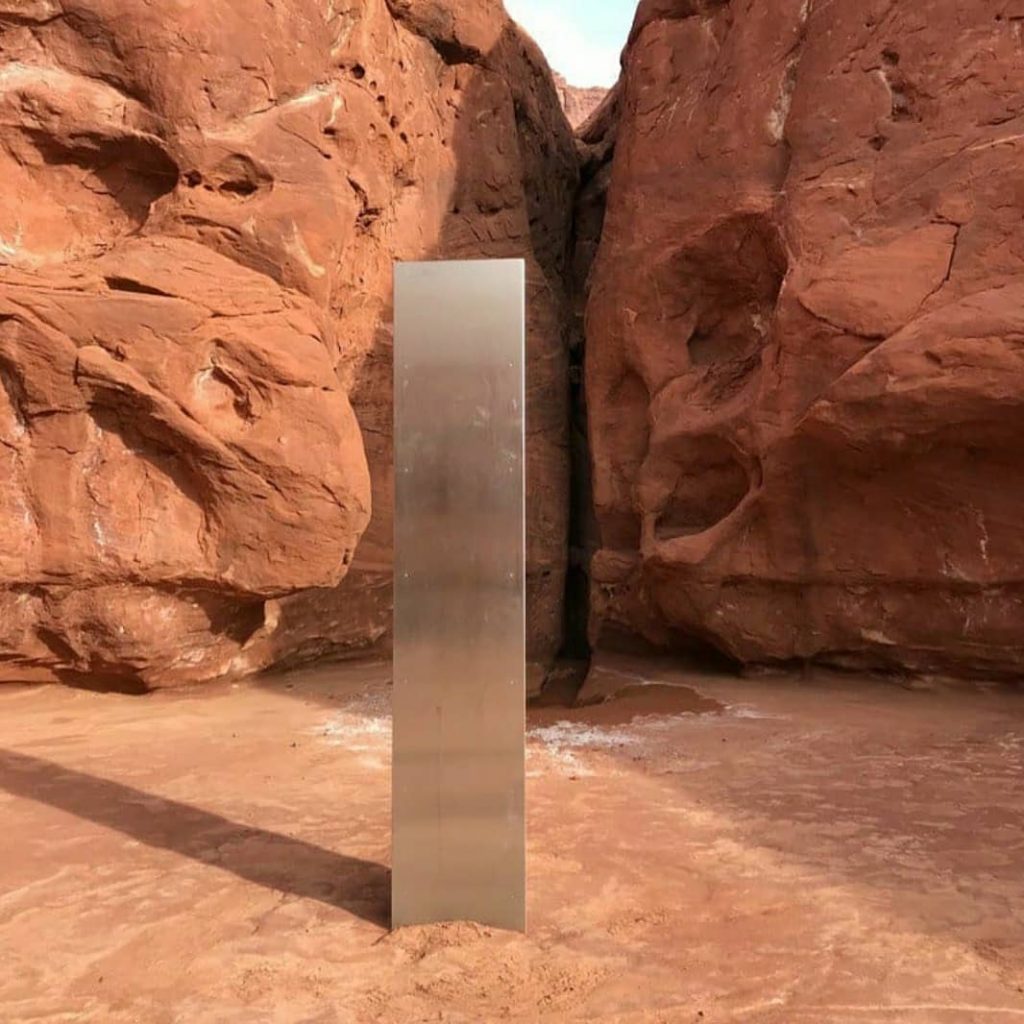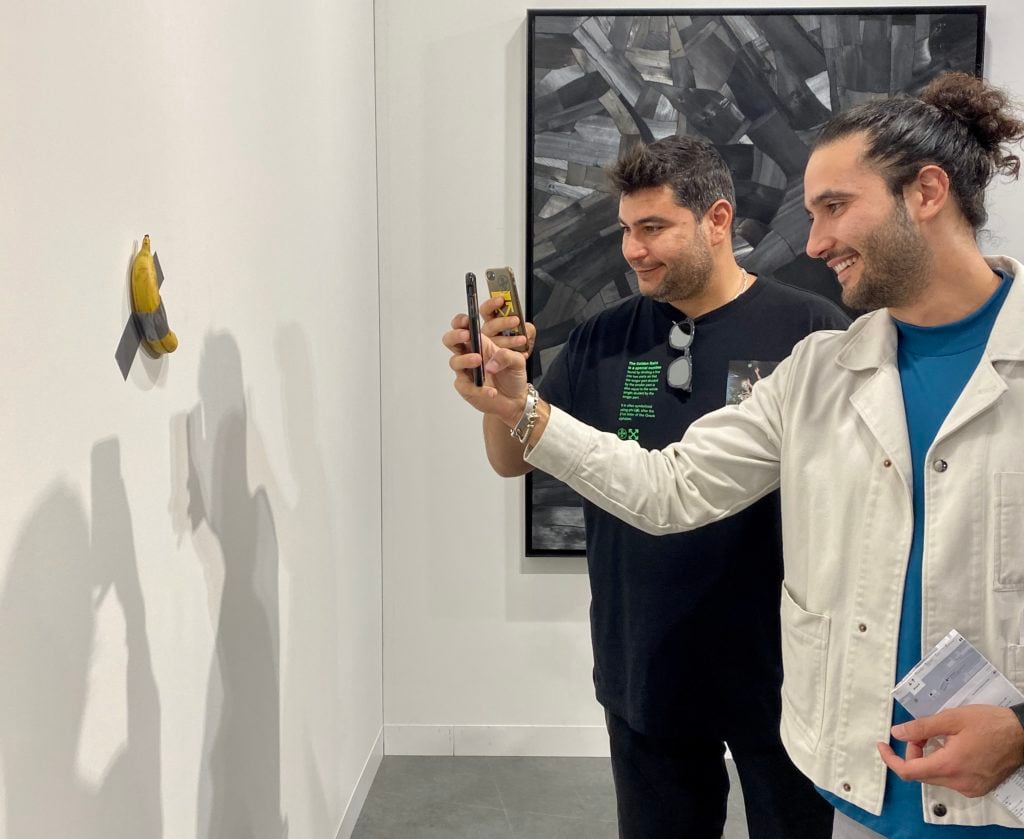Opinion
There Is an Alien Power Driving the Frenzy Over the Utah Monolith. It’s Just Not From Outer Space
Land Art history offers some clues—though the Monolith is very much a creature of the present, not the past (or the future.)

Land Art history offers some clues—though the Monolith is very much a creature of the present, not the past (or the future.)

Ben Davis

The Utah Monolith is a silly story. But as with everything these days, the line between silly and serious gets blurrier and blurrier.
It was discovered on November 18 by biologists assisting Utah’s Division of Wildlife Resources as they were doing a count of bighorn sheep. It was later whisked away in dark of night on Friday by an unidentified group of people, supposedly overheard saying, “This is why you don’t leave trash in the desert.”
In between, a reality-warping wave of overheated internet interest fixed itself onto the nine-foot-tall prism-shaped metal structure in the desert. I’m not sure Utah’s land management authorities understood just what forces they were unleashing when they first light-heartedly announced their find.
The Bureau of Public Safety did not post the object’s coordinates, purportedly so as not to encourage visitors. But the internet abhors a vacuum and the moment is extremely hungry for positive distraction, and so people almost immediately tracked down the site of the Utah Monolith on Google Earth. They also ascertained when, exactly, it was installed: some time between July and October 2016. Torrents of curiosity-seekers headed into the forbidding desert to investigate the mysterious object.
They snapped photos. They photographed themselves planking on it. Locals fretted over danger to nearby Native American sites and artifacts. Visitors trampled vegetation and left behind human waste in their hunt for the unclassified object.
From afar, art fans had fun guessing at what artist it most resembled, digging up references to one of minimalist artist John McCracken’s haunted stelae sculptures, and the artist’s wish to have them discovered in the desert as if the work of aliens. More generally, many mentioned the precedent of Land Art, which seems to me the most illuminating reference—though as much as a point of contrast as a point of comparison.
Land artists in the 1960s and ’70s conceived environment-scaled artworks that interfaced with the sublimity of the surrounding landscape. What’s important to understand about the tradition is that, in the United States, Land Art emerged from the same wave as Minimalism and Conceptual art—art movements obsessed with the industrial and the mediated.
These were quintessential urban art forms, made for a post-Pop art sensibility where culture had become nature. Land Art was both a reaction against those tendencies and exported them back into the non-urban environment, which is why some of the same figures, including Robert Smithson, Walter De Maria, and Nancy Holt, straddled the lines between the various trends.

Robert Smithson, Spiral Jetty (1970).
(Photo by Soren Harward via Wikimedia Commons.)
The more art leaned into the industrial and the conceptual on the one side, the more intense the allure of nature on the other. “I’ve come to the reluctant conclusion,” the critic Lucy Lippard once said, “that much land art is a pseudo rural art made from a metropolitan headquarters.”
But interest in the Utah Monolith isn’t exactly about macho authorial wrestling of form from nature, or even the drama of the ruddy crags in the landscape around it. And it’s certainly not about the formal interest of the workmanlike construction of riveted metal planks over an armature of wood.
The interest is almost entirely… could it be aliens? A secret government device? An occult altar? The idea that it is a random, aborted artistic experiment that people placed and forgot about is almost certainly the least interesting of the theories being thrown out there—if also the most probable.
The Utah Monolith is, in form, not a monolith, but calling it one immediately evoked the prophetic black form in the desert from Stanley Kubrick’s 2001: A Space Odyssey, itself a stand-in for the idea of the unknown. The Utah Monolith thereby comes equipped with the two Janus faces of present-day cultural interest: it offers a form that has enough pre-packaged referential interest to engage the hive mind, while at the same time being open enough to fill in with whatever meaning you want, like a blank coloring-book page.
On that level, artistically, it may be most like this year’s version of Comedian, Maurizio Cattelan’s banana taped to a wall that generated hordes of media coverage and viral riffing at last year’s Miami art fairs. (The memory seems a transmission from another world now, after the cataclysms of 2020.)

Fairgoers take pictures of Maurizio Cattelan’s Comedian, for sale from Perrotin at Art Basel Miami Beach 2019. Photo by Sarah Cascone.
The Utah Monolith’s significant difference to classic Land Art—and its main distinctive artistic feature, as far as I am concerned—is the anonymity of it. That’s a feature, not a bug.
It’s hard to tell scanning the /UtahMonolith subreddit what is a real conspiracy theory and what is a joke, or how much of the interest is wrapped up in a let’s-see-how-far-we-can-take-this kind of game. But the fact that the monolith reads as an enigma, a puzzle, and a portent to unpack is clearly key. As one Utah official remarked, “Many people have been enjoying the mystery.”
The interest in Spiral Jetty, or Lightning Field, or Sun Tunnels connects to your understanding of them as authored installations, the product of artists with particular passions. The interest in the Utah Monolith lasts only as long as the authors remain unknown, their intentions intriguingly, so to speak, alien.
Land Art was a reaction formation to the domination of the man-made and the urban, which sent artists hunting for a sense of place and aura. I see the Utah Monolith phenomenon more as a reaction formation to the domination of information, of a Wikipedia and Google Earth world where everything feels like it should be knowable instantly, where any cocktail-party disagreement over trivia is just a question for Siri.
Against that background, any flicker of mystery, any enigma, any secret knowledge feels powerfully alluring—and all the repressed hunger for mystery and wonder goes flooding into the space it offers.
As art, it must be said, this is a pseudo-aesthetic. But the swarming, social-media fascination is a positive contrast to the deadening disengagement inspired by another pseudo-aesthetic, the typical museum one, where you first look at an image or object and then immediately look left for the text that explains neatly what it means and what you are meant to feel.

The Utah Monolith. (Photo by Patrick A. Mackie, via Wikimedia Commons.)
The black monolith from Kubrick’s 2001 has stuck around for a half century in the hive mind as a cultural image to riff on, to joke about, and to serve as a metaphor for the encounter with the unknown and looming destiny—and this is at least in part because Kubrick’s film never really explains what it means. It is left an enigma. That’s part of what makes artworks robust, their ability to create meaning but also withhold meaning, what you sometimes call “negative capability.”
We are currently in an environment of epidemic over-explanation, a surplus of commercially incentivized information production. That is literally sending people into the desert looking, not for answers, but for questions.